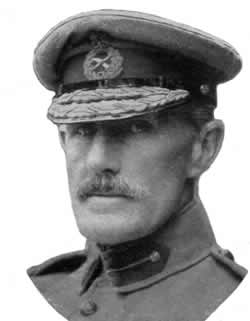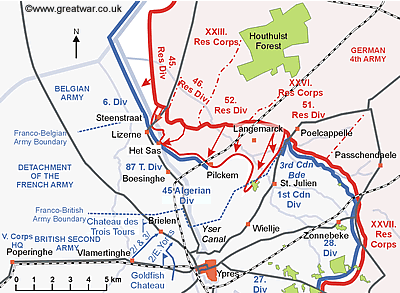 British Second Army HQ responds to the German attack
British Second Army HQ responds to the German attack
22 April 1915: 20.00
First Reports from the Front

|
The first news of the German attack was received at 6.45pm at the British Second Army headquarters (at Hazebrouck in France) of General Sir Horace Smith-Dorrien. An hour later it was followed by a message reporting that the French were retiring and that the left of the 3rd Canadian Brigade had been forced back to Wieltje.(1)
Two telephone messages were then received from the French General Putz, commander of the Détachement d'Armée de Belgique. General Putz confirmed that he had learned from air reports that two simultaneous attacks had been made by the Germans using asphyxiating gases.
General Putz also informed the British that the French right wing was now at Pilckem. This would leave a gap of about 3,000 metres between the French and the 1st Canadian Division. The Canadians were holding the line on the left wing of the British Second Army. The danger for General Smith-Dorrien was that the Germans had broken through the French from the north. This had not only opened the way to Ypres but it also exposed the rear of all the British troops and artillery located in the Ypres Salient east of the Ypres.
Three Reserve Battalions Placed at the Disposal of 1st Canadian Division

At 8pm General Smith-Dorrien placed the four battalions of the 1st Canadian Infantry Brigade (1st, 2nd, 3rd and 4th Battalions), presently located as the Second Army Reserve at Vlamertinghe, at the disposal of the V. Corps commander, Lieutenant-General Sir Herbert Plumer.
2nd and 3rd Canadian Battalions, 1st Canadian Infantry Brigade
General Plumer, in his headquarters at Poperinghe, immediately gave the 2nd Battalion and 3rd Battalion of 1st Canadian Infantry Brigade to General Alderson, commander of the 1st Canadian Division. At 8.30pm General Alderson sent an order that they were to move off at once via the Vlamertinghe-Brielen road in Brielen. The column was to halt when the head reached the Brielen-Ypres road and the senior officer was to report from there to the 1st Canadian Division HQ in the Chateau des Trois Tours, Brielen.
When these two battalions set off for the battle zone they sang 'It's a Long Way to Tipperary'. They marched past the 1st Brigade Canadian Field Artillery, which was still waiting west of Ypres for orders to continue. (2) The men of the 1st Brigade Canadian Field Artillery gave them a rousing cheer as they passed on through the turmoil of an oncoming stream of distraught civilian refugees, old horses, goats and gassed Frenchmen. According to the artillery brigade commander, Lieutenant-Colonel Morrison,
“a gassed Turco [of the French 45th Algerian Division] lying in the road of the column raised himself on his hands, and with glazing eyes, shrieked something in Arabic, reeled out of the way of the column, and fell dead.” (3)
2nd Battalion East Yorkshire Regiment, 28th Division
From the reserve of the British 28th Division (presently in the front line on the right of the Canadian Division) the 2nd Battalion East Yorkshire Regiment, located about a kilometre west of Ypres, was also given to General Alderson. This battalion was moved northwards towards his headquarters near Brielen.
Next>> British 28th and 27th Divisions respond to the German attack
Acknowledgements & Notes
(1) see the page Left of the Canadian line is in danger of envelopment
(2) see the page 1st Brigade Canadian Field Artillery moves up from the reserve
(3) In Flanders Fields, by John F Prescott, p. 86
British Military Operations: France and Belgium 1915, p. 180